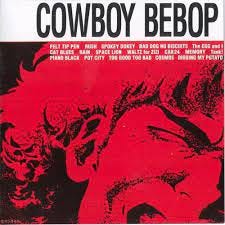Here’s a creator class we don’t celebrate often enough: Stylists.
These are the artists who refine and reanimate rather than upend. They might not be bringers of brand-new astonishments, but they’re vital to the generation-to-generation transmission of ideas about art, and particularly about music. As the rusted-out machinery stoking pop-culture stardom chases the illusory “latest/greatest,” the stylists are in the basement poring over Ellington scores from the 1940s, seeking tiny clues about timelessness. And then seizing on those evocative plush voicings, and using them in new ways.
Since the late ‘90s, there’s been one figure whose work in this direction stands apart from everything else filed under Music: Yoko Kanno, the composer and pianist whose whiplash-inducing cues established the tone and rhythms of the groundbreaking anime series from Japan, Cowboy Bebop.
The adjective that the media reflexively affixes to Kanno’s scores is “eclectic.” That’s the obvious part: Some episodes travel from the blasty big-band series theme to skittering break-beat fantasias to Mannix-style spy-chase-on-crowded-streets son montuno to fizzy vaudeville entre-acts to tortured operatic arias to the cries of a lone harmonica on some cursed prairie. In an episode, each evocation might last mere seconds. But within that time, Kanno conjures atmospheres built on deep understanding: She references the sonic signifiers that distinguish each genre, communicates using their particular orchestrations, and holds up their quirks, which she clearly loves, as musical virtues.
That gee-whiz level of stylization – the send-up level – is where Kanno starts. On the original anime series and subsequent offshoots, Cowboy Bebop follows a rogue crew of intergalactic bounty hunters through close scrapes and epic (often violent) battles. Beautifully drawn scenes crowd into each other, mirrored by cues that start as nursery rhymes (“Cats on Mars,” one of many songs “about” animals) and develop into bebop sprawls. One job of the music is to heighten the tension of seemingly random confrontations as they suddenly go squirrely: The visuals freeze as the music whirls, providing a beat or two of commentary on the chaos.
To listen to the full recordings of the pieces (documented on a series of evocative soundtrack releases and a remix project) is to hear familiar, long-entrenched musical styles being prodded and stretched and radicalized until they’re not kitsch anymore. Until they’re alive all over again, full of delight and relevant as platforms for new expression. Kanno’s got a tune that truncates the form of Ellington’s “Caravan” in a clever grad-student way. It’s meta and brainy but all smiles, too: The soloists breathe thoroughly modern lust into it. She’s got a sweet Bacharach melody that picks up where “Wives and Lovers” leaves off, and then, via a sparkling flute solo, jazz-waltzes into shadowy, less suburban zones. She’s got an uptempo drum-and-bass burner called “Fantaisie Sign” that evokes the streamlined idylls of Stereolab, with vocals sung in French and a melody that gathers poignance as it snakes along.
When (pointedly not “if”) future generations come upon Kanno’s work as both composer and arranger, they’ll get multiple educations at once. They’ll study her magic tricks – among them, her knack for transforming rococo pastiche into profoundly emotional and timelessly lyrical melodies. They’ll marvel at the sweep and scope of her vocabulary. They’ll trace the irreverent ways she reaches across eras – and often-siloed realms – to arrive at a gleeful, deceptively erudite clattering bandwagon of sound that is hers alone.
That’s the sleight-of-hand of a consummate stylist: By not trying to reinvent the wheel, Yoko Kanno wound up reinventing the wheel.
Yes, we have a fancy digital suggestion box. Share your favorite Underloved/Overlooked records here: echolocatormusic@gmail.com.
Please consider subscribing (it’s still free!). And…..please spread the word! (This only works via word of mouth!)








